2018 Porsche 718 Cayman GTS: First Drive
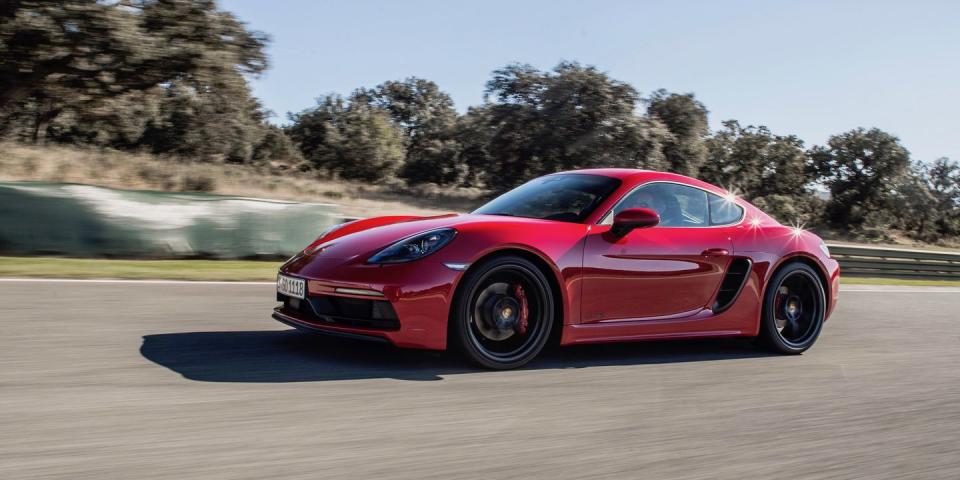
JUST PAST TURN 13 OF CIRCUITO ASCARI, the walkie-talkie crackles to life. “Now I am flat out,” says Porsche driving instructor Matthias Hofsuemmer. His voice echoes over the radio clipped to the map pocket of the Porsche 718 Cayman GTS I’m driving.
This story originally appeared in the May, 2018 issue of R&T - Ed.
We’re playing follow-the-leader around the 3.4-mile track in Málaga, Spain. With 26 turns, elevation changes, and blind approaches, Ascari keeps both car and driver extremely busy. In the Cayman, you hardly notice. Like its predecessors, the new 718 GTS has a supernatural responsiveness that turns even a tricky track like Ascari into a playground.
But the real test comes on the back straight. This Cayman, unlike previous GTS models, is now powered by a turbocharged four-cylinder. I push my right foot to the floor and, sure enough, the car stays glued to the bumper of Hofsuemmer’s 911. “You can see there is really no difference in acceleration between the 911 and the Cayman,” he radios.
The Cayman GTS’s most notable trait, compared with its six-cylinder predecessor, is its immediate, abundant, and unrelenting thrust. The new car’s 2.5-liter produces 15 hp more than the four-cylinder in the current Cayman S, thanks to a revised intake duct and a larger turbocharger compressor wheel, the latter helping to raise boost pressure from 16.7 psi to 18.1. The engine also makes 25 hp more than the previous-generation Cayman GTS’s naturally aspirated 3.4-liter six.
“Now we go faster,” Hofsuemmer says matter-of-factly, as we speed past the paddock and charge toward the chicane at the end of the front straight. It’s like a green flag has just dropped.
Caught off guard, I jab the throttle to keep pace. Lesser cars would hesitate with such a sudden input. The Cayman GTS obediently lunges forward to close the distance.
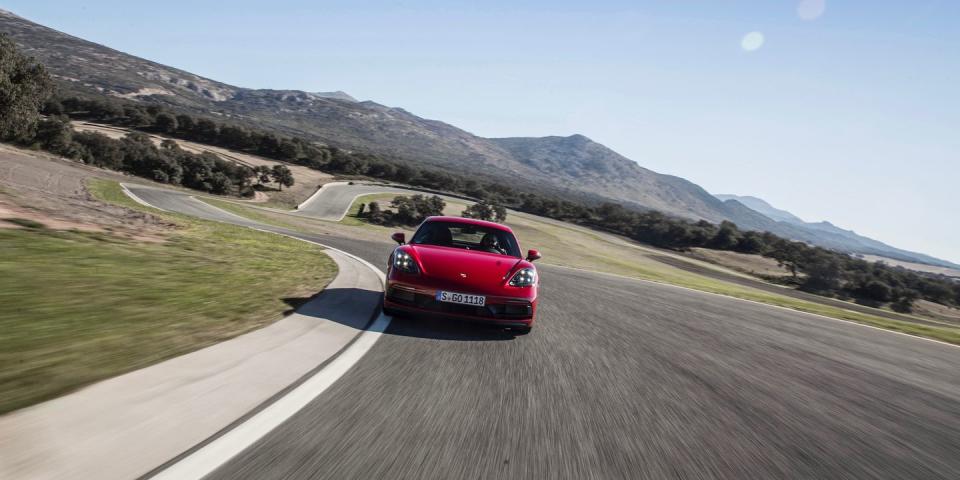
The left–right dance through Ascari’s flowing Senna S happens of its own accord. When powering out of Turn 7, a fast right-hander called Copse, there is time to scan mountains on the horizon before braking hard for the next tight right-hander. Bathurst, Turn 9, crests a small hill and is completely blind. Rather than worry about not being able to see the apex, I notice instead how far the trees stretch over the track, shading the tarmac almost curb to curb.
Ascari is beautiful, and driving it in a 718 Cayman GTS is a beautiful thing. The car gives you room to think, observe, calculate. It seems to stretch time and space by responding exactly as you need it to, freeing your mind from second-guessing. Never once do you wonder how it will behave-or misbehave. And should you slip up at some point, the GTS reacts so predictably and benignly that corrections come without forethought. The car telegraphs exactly what’s going to happen next, so you can adjust in fractions of a second.
Credit goes, as with all Caymans, to the mid-engine layout and the stiff structure. The GTS edition plays up those natural gifts by making standard lots of good stuff that’s optional on lesser Caymans, like a limited-slip diff with brake-based torque vectoring (PTV), a lowered suspension with adaptive dampers (PASM), and dynamic drivetrain mounts. The Cayman I’m driving has the optional sport version of PASM, which drops the car another 10 millimeters. The GTS also gets stiffer anti-roll bars than 718 S models.
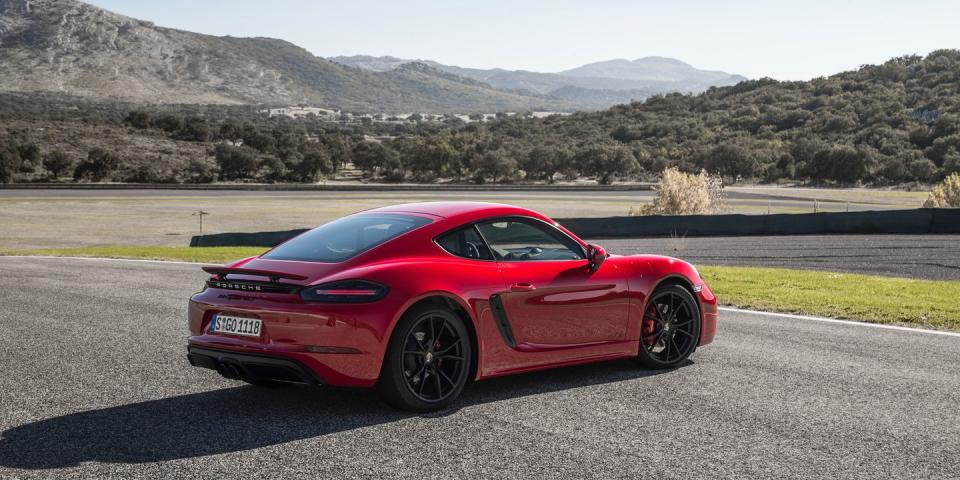
Such a fanatically honed chassis begs for an engine that’s not just powerful, but also responsive. That’s a tall order for a heavily boosted four-cylinder, but this one delivers. There’s not a whiff of turbo lag, and the throttle is easy to modulate. The GTS employs the same anti-lag measures as the 718 S, including variable-geometry turbines, a technology shared with the 911 Turbo. A series of movable vanes direct the exhaust over the turbine to improve low-rpm turbo response and high-rpm efficiency. At low engine speeds, the vanes constrict to accelerate the exhaust headed to the turbine-like putting your thumb over the end of a hose. At higher engine speeds, the vanes open, allowing a larger volume of exhaust gases to move unimpeded over the turbine.
Peak torque comes on quick and persists well into the rev range-a big change from the outgoing version’s high-strung flat-six. Gone are the days of having to rev out the engine for optimal performance. To purists, this might be something to mourn, but as the mid-engined Porsche powers out of Ascari’s tight turns with newfound tenacity, it’s hard to complain. The Cayman GTS not only has more power than its predecessor, but that power is more easily accessed.
There were no Caymans on hand with the standard six-speed manual. Porsche’s PDK is as smooth as a traditional automatic in city driving, yet it fires off gear changes rapidly-bang, bang, bang-every time you get on it. When left to its own devices in Sport Plus mode, the transmission downshifts better than most humans can, always keeping revs in the right range. Say what you will about the purity of a stick shift, but around Ascari, the dual clutch is a boon for focusing on the driving line. (Also, the manual can’t handle quite as much torque as the PDK, and thus has the same rating as the 718 S-309 lb-ft.)
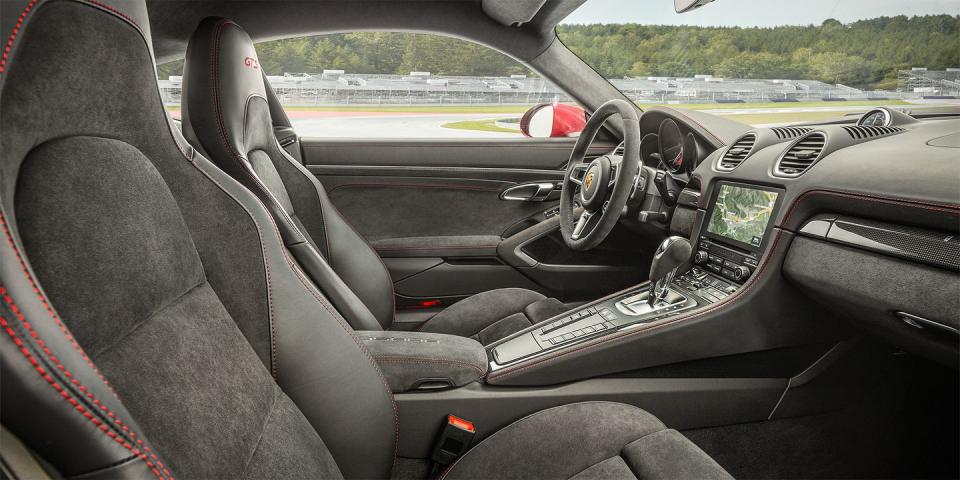
I take to the roads around Ascari in a nearly identically equipped Boxster GTS. Even with the lowered, stiffened suspension, it is so comfortable, it may as well be a Panamera. The adaptive dampers smooth out rough pavement like a steamroller. Trundling over railroad tracks in the taut Sport mode isn’t jarring.
All of the qualities that make the Cayman so easy to drive on the track inspire equal confidence when threading the GTS through the narrow mountain passes of southern Spain. These would be white-knuckle roads in most vehicles, with rock face precariously close on one side and drop-offs on the other. In the GTS, it’s blissful-dialing in the perfect amount of steering input, squeezing the throttle, feeling the power build and catapult the car to the next corner.
Villages of whitewashed buildings blur by, as do farmers in straw hats on steep mountainsides. As on the track, the 718 puts you utterly at ease, because you’re unencumbered by concerns over what the car might do next.
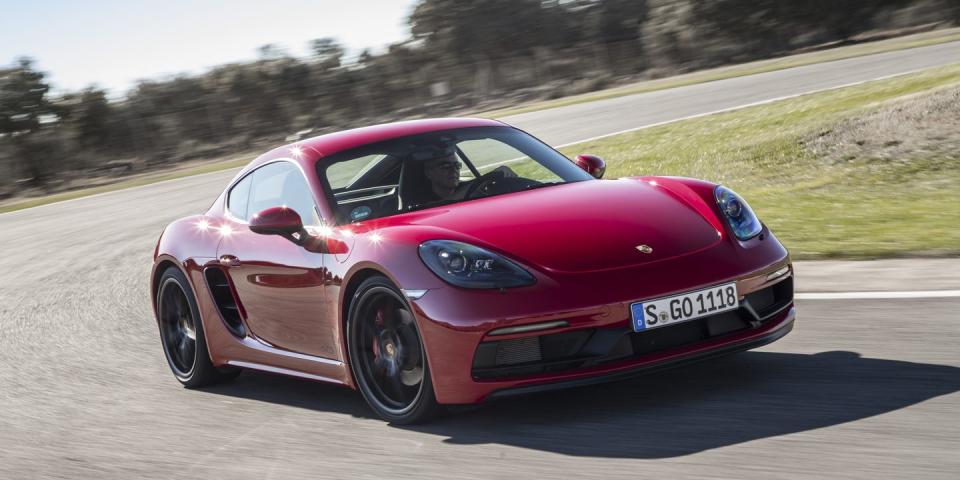
There’s just one problem with the new GTS: You can’t really hear how great it is, despite the standard sport exhaust. Standing in pit lane, waiting to hit the track, it was easy to miss the Caymans blasting by without listening closely. Even inside the cabin, the fat-four is muted, despite a speaker behind the back seat that subtly amplifies the snarl.
Getting any sort of pleasing sound from the engine took some work on Porsche’s part. “When we first heard it, we said, ‘Oh my goodness, we have to do something about the sound,’ ” said Fabian Zink, project manager of powertrains for the 718, pointing out that it has the same firing order as the flat-four in a classic Volkswagen Beetle. So they tinkered until the right noises came through. “We changed some parts of the exhaust system, some parts of the ignition, how to deliver the fuel, and so on.”
The engine does, at least, sound more polished and more menacing than a typical four-cylinder. It just doesn’t thrill.
To the uninitiated, the lack of a little engine noise might seem trivial. And perhaps we should be thanking Porsche for still making engines that produce sound at all, given the electrified future not far on the horizon. But if we’re talking about the joy of driving, which is what the Cayman and Boxster are all about, sound is crucial.
The angry bellows of the very first Cayman I ever drove-a bright-yellow base model with a five-speed manual-still ring in my ears 11 years later. You had to wind the naturally aspirated flat-six into its upper reaches for serious acceleration. And what a pleasure that was, ripping through the gears, those six horizontally opposed cylinders reverberating through the snug interior. The 718 GTS can actually rev slightly higher than that first-gen Cayman-7500 rpm-but with so much torque on tap, it doesn’t need to. And when you do rev it out, the engine purrs more than growls.
Downsizing and turbocharging engines across the entire 718 lineup remains a controversial move that prompts debate even within Porsche. “Everybody’s discussing it,” Zink says.
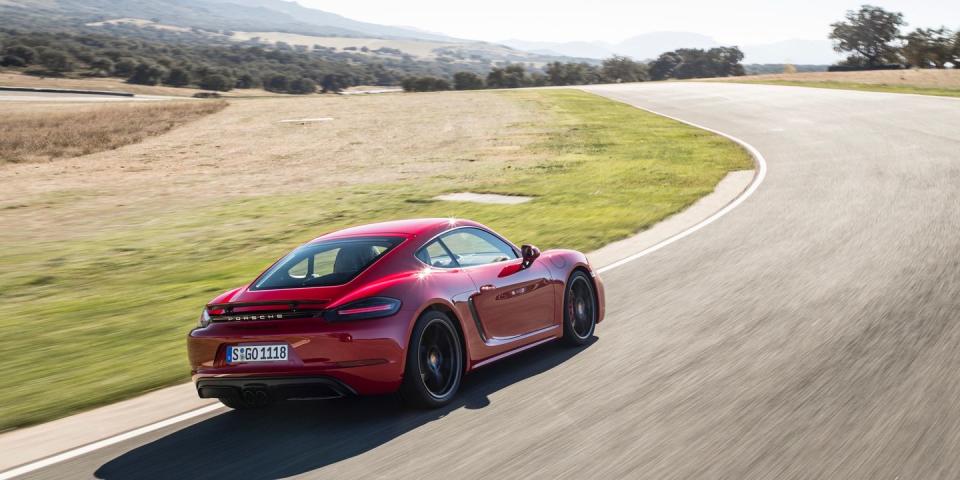
Even so, there’s no doubt that, save for the short-lived Cayman GT4, the latest 718 GTS is the best version of Porsche’s mid-engine two-seater to date. You’d be hard-pressed to find a better-handling car, let alone one that’s just as innocuous to drive daily as it is to thrash on a racetrack. And it’s a bargain, at least as far as Porsches go-less expensive than a Cayman S equipped with all the goodies that come standard here.
The decision comes down to sound versus speed. If being enveloped by lovely noise as you race through the gears is your idea of driving nirvana, maybe look to a 911 or a previous-gen Boxster or Cayman. If having the latest, greatest, and fastest mid-engine Porsche is a must, then the GTS sounds about right.
You Might Also Like

 Yahoo Autos
Yahoo Autos 